Abstract
The hepatic effects of phthalate esters and related compounds on peroxisomal and microsomal enzyme activities were investigated in the intact animal and in primary hepatocyte cultures. In vitro studies with a series of phthalate monoesters demonstrated structure activity differences in the induction of the specific peroxisomal marker KCN-insensitive palmitoyl-CoA oxidation and also of carnitine acetyltransferase. These effects could be reproduced in vivo, and potency differences were also observed between di(2-ethylhexyl) phthalate (DEHP) and its straight-chain isomer, di-n-octyl phthalate. In in vivo studies, DEHP, mono(2-ethylhexyl) phthalate, and clofibrate/clofibric acid produced large increases in liver size and peroxisomal enzyme activities in Sprague-Dawley rats and Chinese hamsters, but had less effect in Syrian hamsters. These effects could be largely reproduced in vitro where good responses were obtained with rat and Chinese hamster hepatocytes, but either little or no effect with Syrian hamster and Dunkin-Hartley guinea pig hepatocytes. Both DEHP and clofibrate appeared to induce similar form(s) of microsomal cytochrome P-450 which exhibited a high specificity towards lauric acid hydroxylation. With a range of hypolipidemic agents, including phthalate monoesters, a good correlation was observed between the induction of peroxisomal and microsomal enzyme activities in rat hepatocyte cultures. These results thus demonstrate a good relationship between the in vivo and in vitro effects of phthalate esters and related compounds and suggest that hepatocyte cultures may be useful for further studies on the hepatic effects of peroxisome proliferators.
Full text
PDF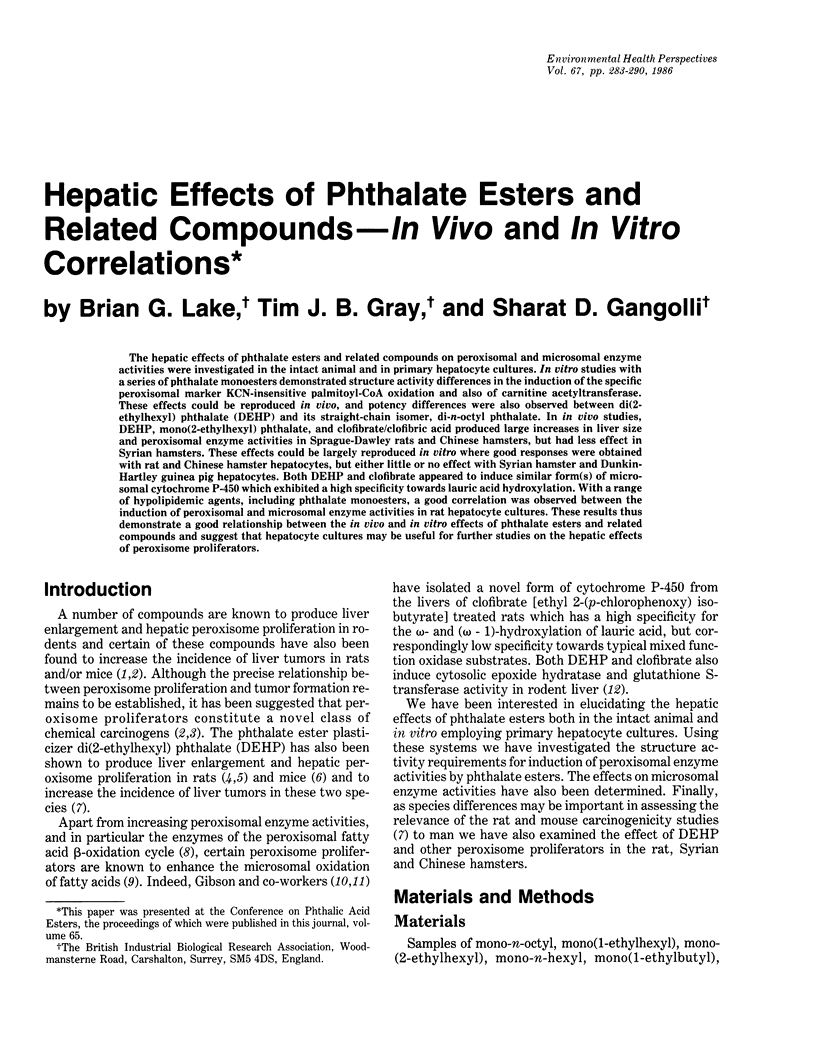
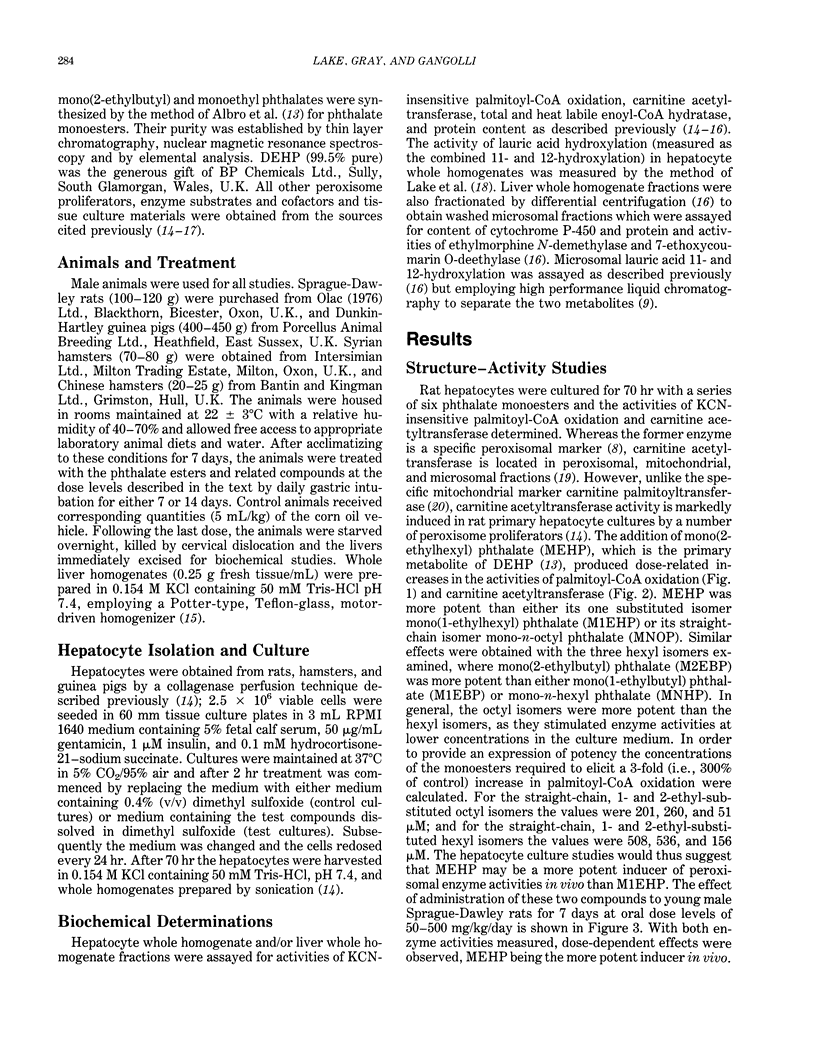


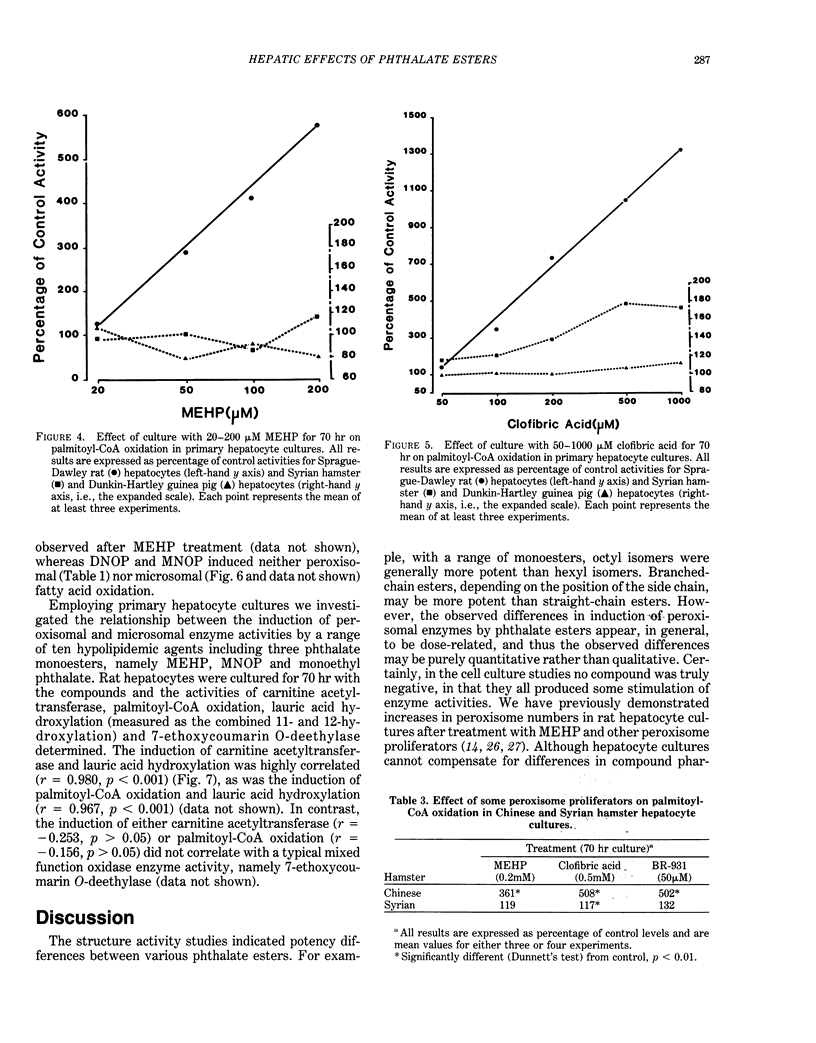
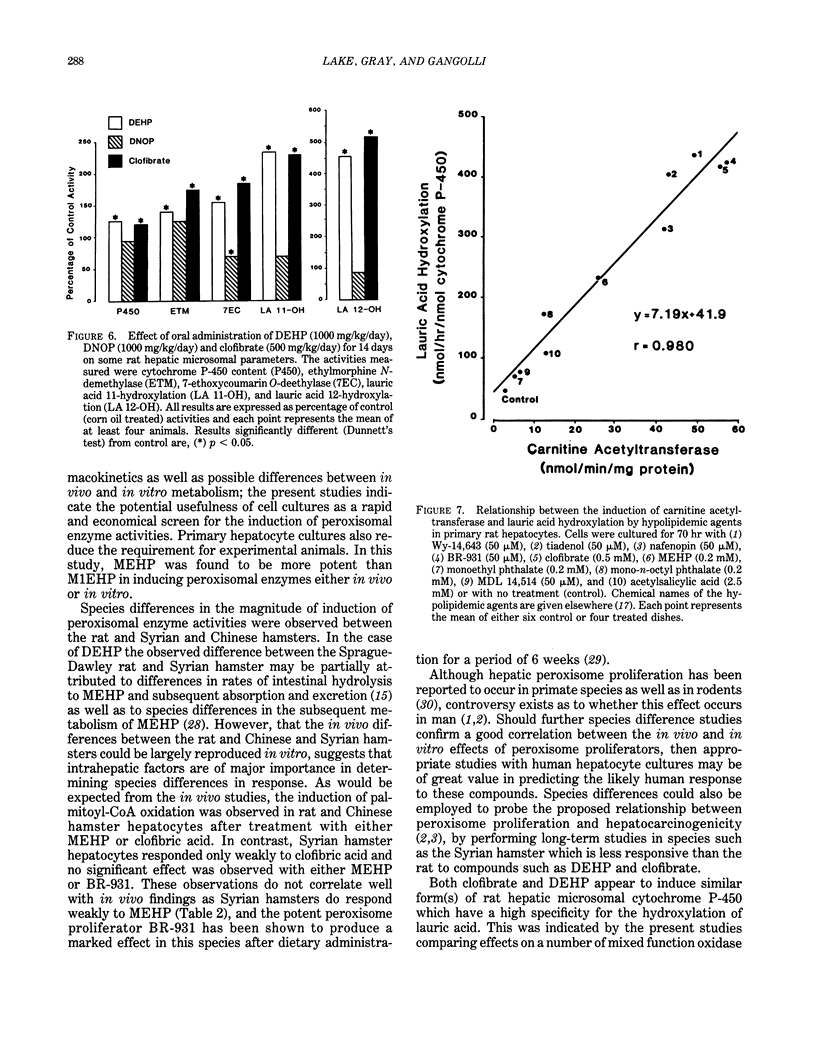
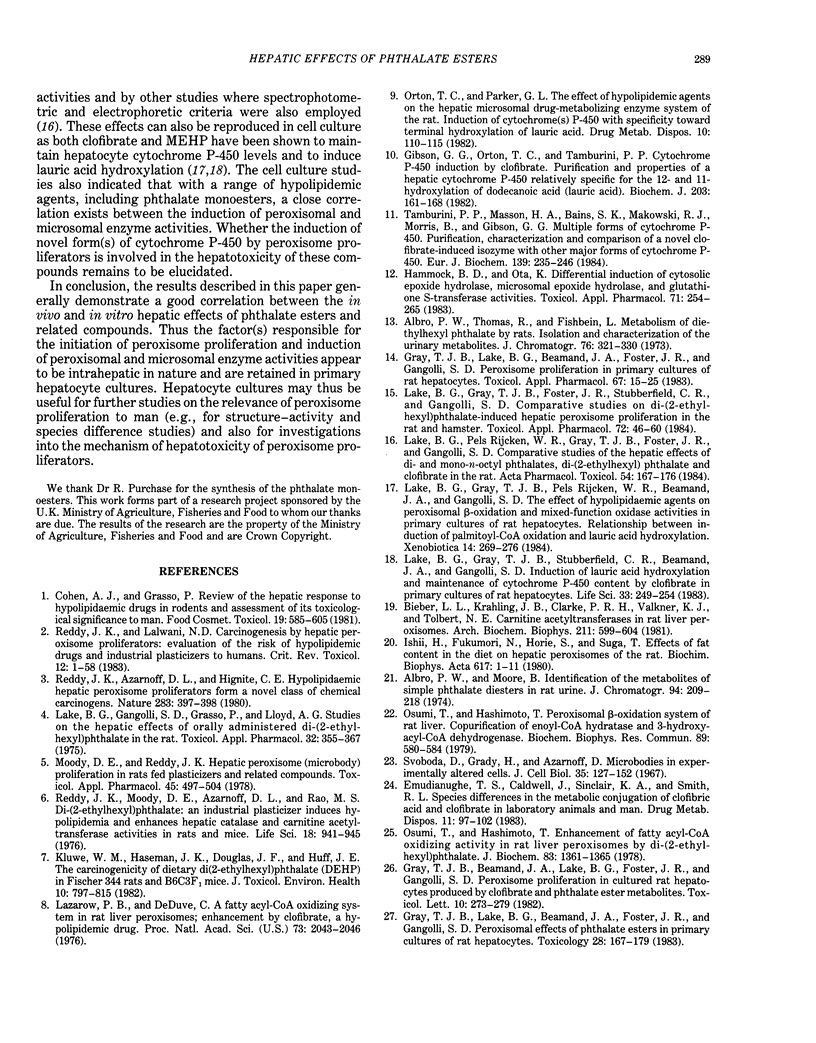

Selected References
These references are in PubMed. This may not be the complete list of references from this article.
- Albro P. W., Corbett J. T., Schroeder J. L., Jordan S., Matthews H. B. Pharmacokinetics, interactions with macromolecules and species differences in metabolism of DEHP. Environ Health Perspect. 1982 Nov;45:19–25. doi: 10.1289/ehp.824519. [DOI] [PMC free article] [PubMed] [Google Scholar]
- Albro P. W., Moore B. Identification of the metabolites of simple phthalate diesters in rat urine. J Chromatogr. 1974 Jul 17;94(0):209–218. doi: 10.1016/s0021-9673(01)92368-4. [DOI] [PubMed] [Google Scholar]
- Albro P. W., Thomas R., Fishbein L. Metabolism of diethylhexyl phthalate by rats. Isolation and characterization of the urinary metabolites. J Chromatogr. 1973 Feb 28;76(2):321–330. doi: 10.1016/s0021-9673(01)96915-8. [DOI] [PubMed] [Google Scholar]
- Bieber L. L., Krahling J. B., Clarke P. R., Valkner K. J., Tolbert N. E. Carnitine acyltransferases in rat liver peroxisomes. Arch Biochem Biophys. 1981 Oct 15;211(2):599–604. doi: 10.1016/0003-9861(81)90494-x. [DOI] [PubMed] [Google Scholar]
- Cohen A. J., Grasso P. Review of the hepatic response to hypolipidaemic drugs in rodents and assessment of its toxicological significance to man. Food Cosmet Toxicol. 1981 Oct;19(5):585–605. doi: 10.1016/0015-6264(81)90509-5. [DOI] [PubMed] [Google Scholar]
- Emudianughe T. S., Caldwell J., Sinclair K. A., Smith R. L. Species differences in the metabolic conjugation of clofibric acid and clofibrate in laboratory animals and man. Drug Metab Dispos. 1983 Mar-Apr;11(2):97–102. [PubMed] [Google Scholar]
- Gibson G. G., Orton T. C., Tamburini P. P. Cytochrome P-450 induction by clofibrate. Purification and properties of a hepatic cytochrome P-450 relatively specific for the 12- and 11-hydroxylation of dodecanoic acid (lauric acid). Biochem J. 1982 Apr 1;203(1):161–168. doi: 10.1042/bj2030161. [DOI] [PMC free article] [PubMed] [Google Scholar]
- Gray T. J., Beamand J. A., Lake B. G., Foster J. R., Gangolli S. D. Peroxisome proliferation in cultured rat hepatocytes produced by clofibrate and phthalate ester metabolites. Toxicol Lett. 1982 Feb;10(2-3):273–279. doi: 10.1016/0378-4274(82)90087-x. [DOI] [PubMed] [Google Scholar]
- Gray T. J., Lake B. G., Beamand J. A., Foster J. R., Gangolli S. D. Peroxisomal effects of phthalate esters in primary cultures of rat hepatocytes. Toxicology. 1983 Sep;28(1-2):167–179. doi: 10.1016/0300-483x(83)90115-4. [DOI] [PubMed] [Google Scholar]
- Gray T. J., Lake B. G., Beamand J. A., Foster J. R., Gangolli S. D. Peroxisome proliferation in primary cultures of rat hepatocytes. Toxicol Appl Pharmacol. 1983 Jan;67(1):15–25. doi: 10.1016/0041-008x(83)90240-5. [DOI] [PubMed] [Google Scholar]
- Hammock B. D., Ota K. Differential induction of cytosolic epoxide hydrolase, microsomal epoxide hydrolase, and glutathione S-transferase activities. Toxicol Appl Pharmacol. 1983 Nov;71(2):254–265. doi: 10.1016/0041-008x(83)90342-3. [DOI] [PubMed] [Google Scholar]
- Ishii H., Fukumori N., Horie S., Suga T. Effects of fat content in the diet on hepatic peroxisomes of the rat. Biochim Biophys Acta. 1980 Jan 18;617(1):1–11. doi: 10.1016/0005-2760(80)90218-0. [DOI] [PubMed] [Google Scholar]
- Kluwe W. M., Haseman J. K., Douglas J. F., Huff J. E. The carcinogenicity of dietary di(2-ethylhexyl) phthalate (DEHP) in Fischer 344 rats and B6C3F1 mice. J Toxicol Environ Health. 1982 Oct-Nov;10(4-5):797–815. doi: 10.1080/15287398209530296. [DOI] [PubMed] [Google Scholar]
- Lake B. G., Gangolli S. D., Grasso P., Lloyd A. G. Studies on the hepatic effects of orally administered di-)2-ethylhexyl) phthalate in the rat. Toxicol Appl Pharmacol. 1975 May;32(2):355–367. doi: 10.1016/0041-008x(75)90226-4. [DOI] [PubMed] [Google Scholar]
- Lake B. G., Gray T. J., Foster J. R., Stubberfield C. R., Gangolli S. D. Comparative studies on di-(2-ethylhexyl) phthalate-induced hepatic peroxisome proliferation in the rat and hamster. Toxicol Appl Pharmacol. 1984 Jan;72(1):46–60. doi: 10.1016/0041-008x(84)90248-5. [DOI] [PubMed] [Google Scholar]
- Lake B. G., Gray T. J., Pels Rijcken W. R., Beamand J. A., Gangolli S. D. The effect of hypolipidaemic agents on peroxisomal beta-oxidation and mixed-function oxidase activities in primary cultures of rat hepatocytes. Relationship between induction of palmitoyl-CoA oxidation and lauric acid hydroxylation. Xenobiotica. 1984 Mar;14(3):269–276. doi: 10.3109/00498258409151411. [DOI] [PubMed] [Google Scholar]
- Lake B. G., Gray T. J., Stubberfield C. R., Beamand J. A., Gangolli S. D. Induction of lauric acid hydroxylation and maintenance of cytochrome P-450 content by clofibrate in primary cultures of rat hepatocytes. Life Sci. 1983 Jul 18;33(3):249–254. doi: 10.1016/0024-3205(83)90383-1. [DOI] [PubMed] [Google Scholar]
- Lake B. G., Rijcken W. R., Gray T. J., Foster J. R., Gangolli S. D. Comparative studies of the hepatic effects of di- and mono-n-octyl phthalates, di-(2-ethylhexyl) phthalate and clofibrate in the rat. Acta Pharmacol Toxicol (Copenh) 1984 Mar;54(3):167–176. doi: 10.1111/j.1600-0773.1984.tb01913.x. [DOI] [PubMed] [Google Scholar]
- Lazarow P. B., De Duve C. A fatty acyl-CoA oxidizing system in rat liver peroxisomes; enhancement by clofibrate, a hypolipidemic drug. Proc Natl Acad Sci U S A. 1976 Jun;73(6):2043–2046. doi: 10.1073/pnas.73.6.2043. [DOI] [PMC free article] [PubMed] [Google Scholar]
- Moody D. E., Reddy J. K. Hepatic peroxisome (microbody) proliferation in rats fed plasticizers and related compounds. Toxicol Appl Pharmacol. 1978 Aug;45(2):497–504. doi: 10.1016/0041-008x(78)90111-4. [DOI] [PubMed] [Google Scholar]
- Orton T. C., Parker G. L. The effect of hypolipidemic agents on the hepatic microsomal drug-metabolizing enzyme system of the rat. Induction of cytochrome(s) P-450 with specificity toward terminal hydroxylation of lauric acid. Drug Metab Dispos. 1982 Mar-Apr;10(2):110–115. [PubMed] [Google Scholar]
- Osumi T., Hashimoto T. Enhancement of fatty acyl-CoA oxidizing activity in rat liver peroxisomes by di-(i-ethylhexyl)phthalate. J Biochem. 1978 May;83(5):1361–1365. doi: 10.1093/oxfordjournals.jbchem.a132044. [DOI] [PubMed] [Google Scholar]
- Osumi T., Hashimoto T. Peroxisomal beta oxidation system of rat liver. Copurification of enoyl-CoA hydratase and 3-hydroxyacyl-CoA dehydrogenase. Biochem Biophys Res Commun. 1979 Jul 27;89(2):580–584. doi: 10.1016/0006-291x(79)90669-7. [DOI] [PubMed] [Google Scholar]
- Reddy J. K., Azarnoff D. L., Hignite C. E. Hypolipidaemic hepatic peroxisome proliferators form a novel class of chemical carcinogens. Nature. 1980 Jan 24;283(5745):397–398. doi: 10.1038/283397a0. [DOI] [PubMed] [Google Scholar]
- Reddy J. K., Lalwai N. D. Carcinogenesis by hepatic peroxisome proliferators: evaluation of the risk of hypolipidemic drugs and industrial plasticizers to humans. Crit Rev Toxicol. 1983;12(1):1–58. doi: 10.3109/10408448309029317. [DOI] [PubMed] [Google Scholar]
- Reddy J. K., Lalwani N. D., Qureshi S. A., Reddy M. K., Moehle C. M. Induction of hepatic peroxisome proliferation in nonrodent species, including primates. Am J Pathol. 1984 Jan;114(1):171–183. [PMC free article] [PubMed] [Google Scholar]
- Reddy J. K., Moody D. E., Azarnoff D. L., Rao M. S. Di-(2-ethylhexyl)phthalate: an industrial plasticizer induces hypolipidemia and enhances hepatic catalase and carnitine acetyltransferase activities in rat and mice. Life Sci. 1976 May 1;18(9):941–945. doi: 10.1016/0024-3205(76)90412-4. [DOI] [PubMed] [Google Scholar]
- Reddy M. K., Lalwani N. D., Qureshi S. A., Reddy J. K. Induction of hamster hepatic peroxisomal beta-oxidation and peroxisome proliferation-associated 80000 mol. wt. polypeptide by hypolipidemic drugs. Hum Toxicol. 1982 Mar;1(2):135–147. doi: 10.1177/096032718200100205. [DOI] [PubMed] [Google Scholar]
- Svoboda D., Grady H., Azarnoff D. Microbodies in experimentally altered cells. J Cell Biol. 1967 Oct;35(1):127–152. doi: 10.1083/jcb.35.1.127. [DOI] [PMC free article] [PubMed] [Google Scholar]
- Tamburini P. P., Masson H. A., Bains S. K., Makowski R. J., Morris B., Gibson G. G. Multiple forms of hepatic cytochrome P-450. Purification, characterisation and comparison of a novel clofibrate-induced isozyme with other major forms of cytochrome P-450. Eur J Biochem. 1984 Mar 1;139(2):235–246. doi: 10.1111/j.1432-1033.1984.tb07999.x. [DOI] [PubMed] [Google Scholar]


